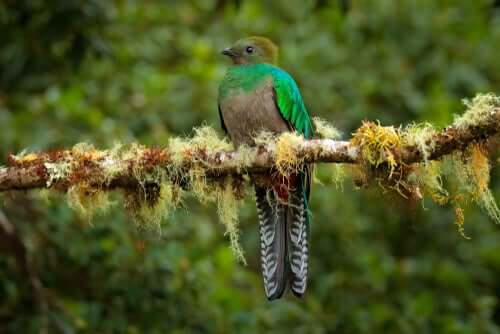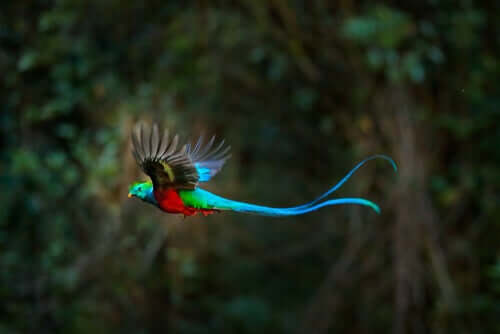Resplendent Quetzal: Beautiful and Mysterious


Written and verified by the biologist Paloma de los Milagros
The resplendent quetzal, whose scientific name is Pharomachrus mocinno, is one of the most emblematic birds in South America. Its color and symbolism make it a rather sought-after species.
Etymologically, the name quetzal has its roots in Náhuatl (Aztec), a Mexican language. The term quetzalli means “tall upstanding feather.” The beauty of this bird, both in color and slenderness, inspired myths that it was a divine creature.
Because of this, the Aztecs connected the bird to their god Quetzalcóatl (the plumed serpent), and the Maya associated it with Kukulkan (their version of the same feathered god). So, the sacred value of a quetzal’s feathers was so high that only priests and high rulers could own them.
Resplendent quetzal: morphology and behavior

Keep in mind though, that you can’t accurately describe the physical appearance of the resplendent quetzal, without distinguishing between adult females and males. The latter is a lot more striking and eye-catching.
The males have four supracaudal (situated above the tail) cover feathers of intense iridescent emerald green. In fact, one can observe either blue or golden tones depending on the light. This glowing effect is what gives the bird such a sacred appearance. Also, the feathers on the belly of the males are electric red, but these are lacking in the females. They have a less striking green and grayish general tonality.
Another distinctive feature of the females is the presence of a black mouth. And, in addition to that, a shorter tail that’s white with dark horizontal lines across.
The resplendent quetzal is also known as tepeaguacate (the small-avocado of the Persea tree) due to its predilection for this fruit. In addition, their diet includes other fruits such as blackberries and also insects.
Mating song
We must highlight their mating song. They sing it between the months of February and June, and, of course, this coincides with their breeding season. The softness of the whistle is linked to an old Guatemalan legend that attributes the loss of intensity of the sound to the Spanish invasion.
The structure of their nests tends to take advantage of small log cavities, but they’re never at ground level. Each female lays at least two eggs, which both parents take turns to incubate throughout the day. At the 20th day, the hatching of tiny “naked” chicks takes place. But, in less than a month, they’ll develop the necessary plumage to make short flights and procure their own food.
Distribution and conservation status

This bird is usually inactive and doesn’t have a major environmental impact. In fact, the lush vegetation that results from the permanent humidity of that area provides a good supply of fruits for them to feed on throughout the year.
Currently, the International Union for the Conservation of Nature considers that this bird species is threatened. Paradoxically, the attractiveness and mythology associated with the origin of this species are the factors that are most detrimental to their existence and well being. Unfortunately for them, they are an object of desire and therefore victims of poaching and illegal trade.
The resplendent quetzal is unable to live in captivity, and they usually die shortly after capture.
Finally, climate change and the destruction of their habitat both contribute to the progressive disappearance of more than half of their nesting sites.
We can hope that, despite the Guatemalan legend mentioned above, the quetzal will find its true voice again.
All cited sources were thoroughly reviewed by our team to ensure their quality, reliability, currency, and validity. The bibliography of this article was considered reliable and of academic or scientific accuracy.
- EcuRed. Quetzal. (S.f). Recuperado de https://www.ecured.cu/Quetzal#Descripci.C3.B3n
- Peña, E.(2001). Animal Diversity Web. Pharomachrus mocinno. Recuperado de https://animaldiversity.org/accounts/Pharomachrus_mocinno/
- Olguín, M. (2016). Gaceta Digital UNAM. El quetzal, ave al borde de la extinción. Recuperado de http://www.gaceta.unam.mx/20160104/el-quetzal-ave-al-borde-de-la-extincion/
This text is provided for informational purposes only and does not replace consultation with a professional. If in doubt, consult your specialist.